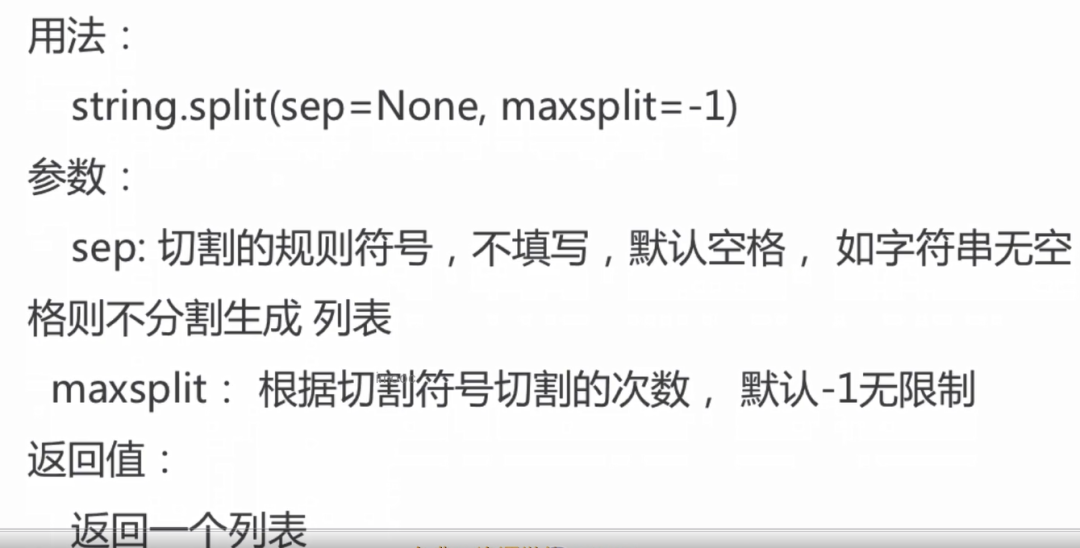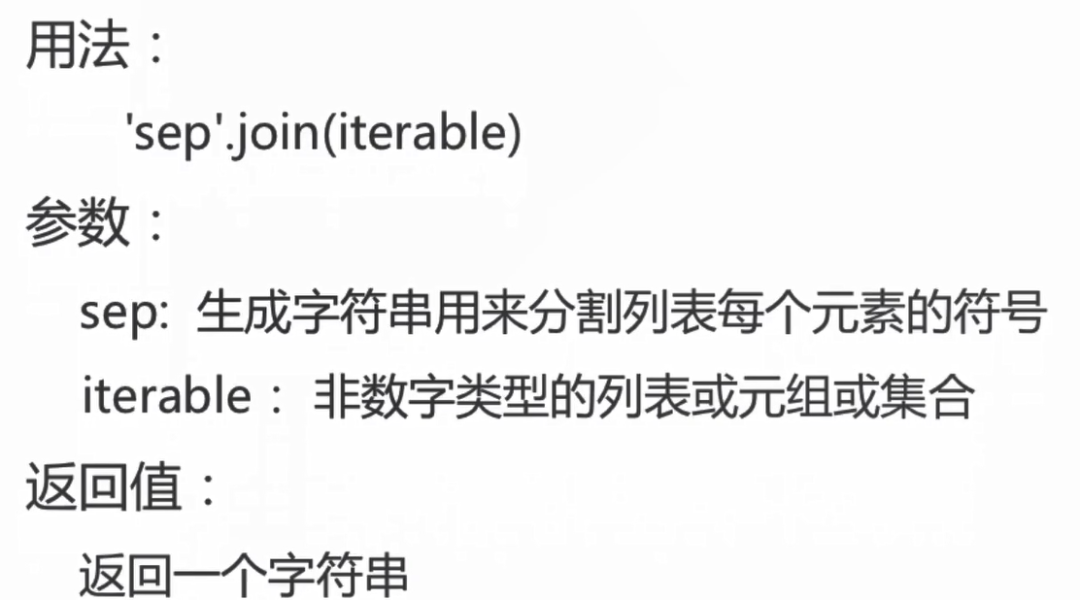python全栈开发《65.字符串与列表之间的转换》
python全栈开发《65.字符串与列表之间的转换》

1.字符串转列表的函数:split
1.1split的功能
将字符串以一定规则切割转成列表。
1.2split的用法

string:是需要被转换成列表的字符串。
sep:是一个符号。split将按照这个符号对字符串进行切割。
如果不填写(sep参数默认是个空格),会把当前字符串整个放入一个列表中。
如果字符串中有空格,且不填写sep这个参数,那么split函数就会默认按照空格将字符串进行切割。
maxsplit:是希望被切割的次数。默认是无限制次数。
split函数会返回一个新的列表。
info = 'my name is dewei'
info_list = info.split()
print(info_list)
运行结果:
['my', 'name', 'is', 'dewei']
定义了一个字符串info,这个字符串的每个单词之间用空格隔开。
通过info调用内置函数split()执行,()内没有填写任何参数,所以sep默认是按照空格来填写的。
如果字符串(这里指info)中有空格,会按照空格切割。没有空格,会将字符串以一个成员的形式放入列表中。
当然,这里info中是有空格的,执行split函数,返回了一个列表并赋值给info_list变量。
1.3代码
例1:
# coding:utf-8
a ='abc'
print(a.split())
b ='a,b,cd'
print(b.split(','))
c = 'a|b|c|d'
print(c.split('|',1))#只用|切割一次。
d = 'a|b|c|d'
print(d.split('|',2))#只用|切割两次。
运行结果:
['abc']
['a', 'b', 'cd']
['a', 'b|c|d']
['a', 'b', 'c|d']
例2:
f = ''
print(f.split(''))
运行结果:报错。
Traceback (most recent call last):
File "/Users/llq/PycharmProjects/pythonlearn/change/change_str_list.py", line 16, in <module>
print(f.split(''))
ValueError: empty separator
例3:
f = ' a~b~c '
print(f.split(''))
运行结果:报错。
/Users/llq/PycharmProjects/pythonlearn/pythonlearn/change/bin/python /Users/llq/PycharmProjects/pythonlearn/change/change_str_list.py
Traceback (most recent call last):
File "/Users/llq/PycharmProjects/pythonlearn/change/change_str_list.py", line 16, in <module>
print(f.split(''))
ValueError: empty separator
进程已结束,退出代码为 1
split函数的sep参数是不能传一个空字符串的。
2.列表转字符串的函数:join
2.1join的功能
将列表以一定规则转成字符串。(实际上,不仅仅是列表,包括元组和集合,都可以用join函数转成字符串。这里用列表作一个代表。)
2.2join的用法

'sep':是一个字符串。sep是生成字符串的规则符号。通过'sep'调用join函数。
interable:代表列表、字符串、元组和集合。
join函数会返回一个字符串。()中的interable的每个成员会通过join函数前面的'sep'连接起来。
test = ['a','b','c']
new_str = '.'.join(test)
print(new_str)
运行结果:
a.b.c
2.3代码
例1:列表中的成员是数字,通过join函数转换成字符串,运行后报错。
test2 = [1,'a','b']
print('|'.join(test2))
运行结果:
Traceback (most recent call last):
File "/Users/llq/PycharmProjects/pythonlearn/change/change_str_list.py", line 23, in <module>
print('|'.join(test2))
TypeError: sequence item 0: expected str instance, int found
只要列表里有一个是数字成员,就不能通过join函数进行转换。
例2:列表中的成员是字典,通过join函数转换成字符串,运行后报错。
test3 = [{'name':'dewei'},{'name':'xiaomu'}]
print('.'.join(test3))
运行结果:
Traceback (most recent call last):
File "/Users/llq/PycharmProjects/pythonlearn/change/change_str_list.py", line 26, in <module>
print('.'.join(test3))
TypeError: sequence item 0: expected str instance, dict found
例3:列表中的成员是元组,通过join函数转换成字符串,运行后报错。
test3 = [(1,),('a','b')]
print('.'.join(test3))
运行结果:
Traceback (most recent call last):
File "/Users/llq/PycharmProjects/pythonlearn/change/change_str_list.py", line 26, in <module>
print('.'.join(test3))
TypeError: sequence item 0: expected str instance, tuple found
例4:列表中的成员是None和True,通过join函数转换成字符串,运行后报错。
test3 = [None,True]
print('.'.join(test3))
运行结果:
Traceback (most recent call last):
File "/Users/llq/PycharmProjects/pythonlearn/change/change_str_list.py", line 26, in <module>
print('.'.join(test3))
TypeError: sequence item 0: expected str instance, NoneType found
以上总结:只有字符串类型的列表才可以通过join进行合并。
3.代码
3.1split函数和join函数结合起来:
过去将字符串反转,最快的方式是通过索引的形式。这一次采用字符串,帮助它们排序。也就是sort功能。
sort_str = 'a b d f i p q c'
sort_list = sort_str.split(' ')#sep里有一个空格,不是一个空字符串。
print(sort_list)
sort_list.sort()
print(sort_list)
sort_str = ' '.join(sort_list)
print(sort_str)
运行结果:
/Users/llq/PycharmProjects/pythonlearn/pythonlearn/change/bin/python /Users/llq/PycharmProjects/pythonlearn/change/change_str_list.py
['a', 'b', 'd', 'f', 'i', 'p', 'q', 'c']
['a', 'b', 'c', 'd', 'f', 'i', 'p', 'q']
a b c d f i p q
3.2sorted函数:将字符串转换成列表并排序。
sorted函数可以对任何的类型进行处理,sort函数只是列表的内置函数。
sort_str_new = 'abdfipqc'
print(sort_str_new)
res = sorted(sort_str_new)
print(res)
print(''.join(res))
运行结果:
/Users/llq/PycharmProjects/pythonlearn/pythonlearn/change/bin/python /Users/llq/PycharmProjects/pythonlearn/change/change_str_list.py
abdfipqc
['a', 'b', 'c', 'd', 'f', 'i', 'p', 'q']
abcdfipq
进程已结束,退出代码为 0
注意:split函数和join函数都是字符串的内置函数。
